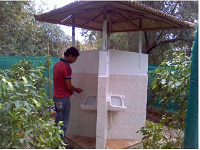Sanitation
Analysis of Delhi's budgetary allocations for water and sanitation services in slum areas Article in Economic and Political Weekly
Posted on 22 Nov, 2014 10:30 AMThis article in Economic and Political Weekly, by analysing various budget documents, attempts to capture the quantum of budgetary outlay for Water and Sanitation Services (WSS) in the slums of Bawana and Bhalaswa in Delhi. Further it captures various systemic weaknesses that impede the effective delivery of WSS in these two slum areas.
A communication and advocacy strategy framework for sanitation and hygiene by the Ministry of Drinking Water and Sanitation and UNICEF 2012-17
Posted on 22 Nov, 2014 10:30 AMThe number people practicing open defecation in India is more than 600 million. Though the access to improved sanitation has increased since 2000 the pace of change has been slow. If the current trend continues then it will be difficult for the country to meet its Millenium Development Goal for sanitation. Thus accelerating access to and use of toilets and hygiene practices have become a national priority.
A toilet that loves the environment: A film by the Himalaya Seva Sangh highlighting Uttarakhands experience with ecosan toilets
Posted on 22 Nov, 2014 10:30 AMThe Himalayas are inhabited by 40 million people, most of whom are dependent on agriculture and animal husbandry. The prevalent water scarcity also means a lack of water for sanitation. In this case, both open defecation and conventional sewerage pose a health risk. Conventional toilets not only consume a lot of water, but the effluent also pollutes groundwater.

A resource book on waterless urinals: an ecological sanitation method that saves water energy and uses urine as a resource
Posted on 22 Nov, 2014 10:30 AM
Waterless urinals (WLU) save water, energy and use urine as resource ( Image courtesy: R Sakthivel)
Towards self reliance and access to safe drinking water and secure sanitation in north Bihar : A report by Megh Pyne Abhiyan
Posted on 22 Nov, 2014 10:30 AM
Wastewater irrigation in Hubli-Dharwad Karnataka enables farmers to diversify their cropping practices: A paper in the Environment and Urbanisation Journal
Posted on 22 Nov, 2014 10:30 AMThis paper 'Wastewater irrigation in Hubli–Dharwad, India: I
Compendium of sewage treatment technologies by Indian Institute of Technology Kanpur
Posted on 22 Nov, 2014 10:30 AMThis compendium of sewage treatment technologies by the Indian Institute of Technology (IIT), Kanpur has been prepared, based on primary and secondary data gathered from operation of sewage treatment plants (STPs) in the country over the last two decades.
Water Towards a paradigm shift in the Twelfth Plan A paper by Mihir Shah in the EPW
Posted on 22 Nov, 2014 10:30 AMA fundamental change in the principles, approach and strategies of water management in India has been proposed in the Twelfth Plan
Why is this paradigm shift needed ?
Green Sanitation Foundation: an NGO in Kolkata develops biotoilets a unique toilet technology
Posted on 22 Nov, 2014 10:30 AMBiotoilets are biological toilets, named so because they convert human waste into non toxic, non contaminating water compatible with environmental standards, through application of multi strain bacteria culture, using aerobic forms of bacteria.
Cost recovery in urban water services : Select experiences in Indian cities A report by Water and Sanitation Program
Posted on 22 Nov, 2014 10:30 AMThe report draws on the report by Water and Sanitation Program (WSP) study from 2008 which made a comparative analysis of 23 urban local bodies (ULBs)—looking at seven cities in detail and another 16 based on secondary data to understand the factors affecting cost recovery.





